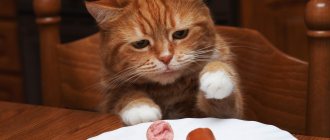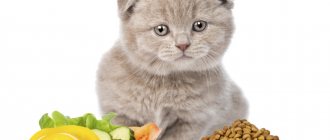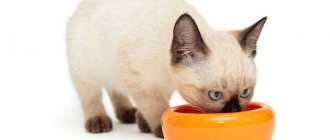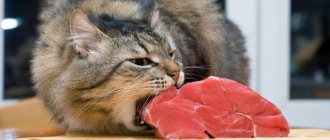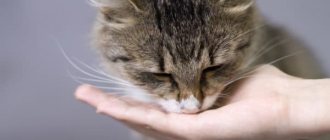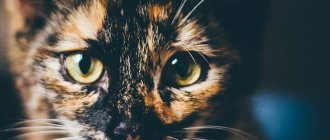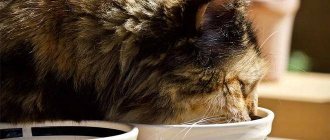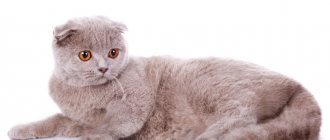The health, activity and well-being of a pet depends, first of all, on proper and balanced nutrition. The cat must receive the macro- and microelements, vitamins, proteins and other substances it needs for the proper functioning of all systems of its body.
Proper nutrition ensures resistance to infections, minimizes the risk of developing diseases and their transition to a chronic form. Thus, the issue of choosing food for Scottish cats and preparing their diet must be approached with all responsibility and seriousness.
Tips on choosing food and preparing a diet for Scots.
Nutrition rules
For an adult pet, the daily diet of natural feeding should be at least 200 grams per day.
The exact weight is calculated for each animal individually, based on its weight and age. The norm is 3-5% of the cat’s body weight, in terms of energy value this is approximately 335 kilojoules. If the cat is young and active, the norm should be 10-15 higher.
For kittens under the age of 1 year, pregnant and lactating cats, the norm should also be increased. The weight of the daily diet should be at least 10% of the animal’s body weight. For castrated and sterilized pets, the diet, on the contrary, should be reduced so as not to cause obesity and chronic diseases associated with excess weight.
The choice of nutrition depends on the tolerance of a particular product. It is easier to balance natural food, since you can use a variety of vegetables, meat, offal, dairy and others.
You should know that plant proteins are poorly absorbed by the body of predators. If they prevail, the risk of pathologies and diseases increases many times over. For a cat, the proportion of animal and vegetable protein should be 40% to 60%.
Carbohydrates should be limited for Scottish Fold and Straight-eared cats. Their share should be no more than 12%. A high proportion of carbohydrates in food can lead to the development of gastrointestinal (gastrointestinal) diseases. The pancreas of the animal is the most vulnerable and suffers first. Veterinarians and animal nutrition specialists have established the optimal proportion of proper nutrition:
- 52% protein;
- 12% carbohydrates;
- 36% fat.
Fats are also important, as they are necessary to keep your cat active. Their share should not be lower than 5%, the optimal level is 15%. First of all, it must be fat of animal origin; vegetable fat does not have any beneficial properties for the Scots body. If the animal receives such nutrition, the risk of diseases and pathologies is minimized.
To give or not to give kittens raw meat?
Is raw meat allowed for kittens? These debates have been going on between veterinarians and breeders for a long time - there is no common opinion. Some people claim that raw meat is more natural for cats, because in nature cats do not cook meat. Others are categorically against it, because meat sometimes contains parasites and infections, which are not always killed by cold (meat can only be given to cats after three days of freezing). At the same time, cooking kills many beneficial substances - and the diet becomes poorer, sometimes to critical levels. In fact, this discussion is meaningless, since more than a hundred years ago a large-scale experiment was conducted that gave a clear answer to this question.
Rate and share!
What to feed a kitten: breakdown by month
The Scottish Fold cat requires its own care and feeding. The animal's food should differ depending on the degree of maturity. A kitten's diet is very different from that of an adult cat. This is due to differences and features in the digestive system. The required amount of dry food is presented in the table below (recommendations from different manufacturers may vary slightly). Let's take a closer look at creating a natural feeding diet.
Calculation table for dry food for Scottish kittens.
1 month
During this period, the kitten begins to receive its first complementary foods. The basis is cat milk or special ready-made formulas for feeding kittens. During this period, you need to start introducing the following products:
- boiled finely chopped chicken;
- boiled cereals with milk;
- chopped boiled vegetables - cabbage, apple, carrots;
- fermented milk products, cottage cheese with a high calcium content is especially useful.
All food should be at room temperature. After eating, there should be no pieces of food in the bowl. Anything that the kitten hasn’t eaten should be thrown away and the dishes themselves should be washed thoroughly. The diet for a month to six months should be rich and contain substances necessary for the growth and development of the kitten.
Second month
During this period, the kitten begins to actively grow and new teeth appear. Therefore, the diet must correspond to this. Food for Scottish kittens should have:
- boiled chicken or beef;
- low-fat fermented milk products;
- porridge;
- raw vegetables;
- egg yolk, which can be added to meat.
The kitten's food should not contain salt or spices, and the meat should be given in the form of small pieces so that the animal does not choke.
Selecting a diet for a kitten.
Third month
At this age, the kitten already has formed teeth. Meat can be given in the form of medium cubes. The menu itself looks like this:
- boiled beef;
- skinless chicken;
- cereals;
- yolk;
- cottage cheese;
- fermented baked milk;
- lean fish (frozen and without bones);
- meat by-products.
Chicken hearts and necks are suitable as offal. Before giving them to the animal, they must be brought to room temperature.
Fourth month
The diet includes more products:
- raw beef;
- boiled chicken;
- porridge;
- 2 yolks per week, raw or boiled;
- raw vegetables;
- fruits;
- sea fish;
- various fermented milk products.
Fish is introduced into the diet in stages, starting with small pieces, as it can cause allergic reactions in the animal. It is strictly forbidden to give raw fish, especially river fish. There are a lot of bones and a risk of parasites.
Fifth month
During this period, food consists of the following products:
- raw or boiled lean meat;
- dairy products;
- vegetables;
- cereals;
- meat broths;
- greenery.
From this period, the kitten can receive vitamin supplements, which must be prescribed by a veterinarian.
Material on the topic: what to feed British breed cats.
Six months
At this age, cats undergo a castration procedure. After this operation, nutrition must be adjusted. It should look like this:
- foods high in fiber and vitamins;
- exclude fish;
- porridge;
- offal once a week;
- more raw vegetables;
- You can give meat broths several times a week.
A Scottish kitten receiving ready-made food should only eat food that is specifically intended for castrated (sterilized) individuals. It is worth choosing holistic, premium, super-premium class for a specific breed.
Kitten 7-12 months
At this age, the kitten becomes a teenager. He should receive food 4 times a day. Some animals themselves refuse fractional meals and switch to 2-3 meals a day. A cat's diet is at least 180 grams of food.
Feeding adult cats
You need to feed your Scottish kitten thoughtfully, like any purebred pet. These breeds are more picky about their diet. An adult animal should eat:
- Lean meats. It is preferable to choose turkey and veal that has undergone heat treatment.
- Fish several times a week if the animal is not castrated. Fish contains phosphorus, which can lead to diseases of the genitourinary system, especially if it is sterilized.
- Porridge is a must in your diet. Oatmeal or rolled oats and rice are especially good.
- Vegetables, greens. They can be raw or boiled. They can be added to meat and porridge.
- To ensure that the animal receives vitamins, a vitamin-mineral complex is suitable.
Appetite is affected by the temperature in the apartment and the time of year. In winter and autumn, cats may eat more often and more; during this period, their feeling of hunger becomes more acute.
In summer or if the apartment is hot, the cat will drink more often. Every animal should have unlimited access to clean water. Very often, tap water can be hard and contain chlorine. Therefore, it is better to give bottled or filtered water.
An essential substance for cats is taurine. This is a special amino acid necessary for cardiac activity and vision. This substance is found in animal protein. Meat should play a key role in your pet's nutrition.
How to feed sterilized Scots
After such surgery, cats are prone to weight gain and the development of urolithiasis. In this case, you need to switch your pet to a different diet. Homemade food for a Scottish kitten should be adjusted towards reducing the fat content of the food. There are several basic recommendations for such animals:
- Regular food for neutered cats is not suitable. Do not mix natural diet and prepared food.
- If your cat receives raw and dry food, they must be the same brand.
- You need to feed in small portions, calculated according to age, weight, and health status. Give food four times a day.
The food must meet certain requirements: protein content of at least 50%, exclude phosphorus, potassium, calcium, magnesium. These trace elements cause the development of urolithiasis. Carbohydrates affect weight gain, their content should be reduced to 25%.
The best food for Scottish kittens
NOW Natural holistic (with vegetables and fresh meat, grain-free)
Rating: 4.9
Natural, hypoallergenic, holistic food for kittens is unique in its kind - the first grain-free cat food. Suitable as a permanent diet for kittens aged 5 weeks to 1 year, as well as pregnant Scottish cats. A distinctive feature is all-natural turkey and duck meat raised on Canadian farms (no by-products - only fresh boneless meat). This is a source of high-quality, easily digestible protein. The absence of grains guarantees a minimal likelihood of developing allergic reactions in a young animal.
NOW Natural holistic food for Scottish kittens contains a whole complex of amino acids (to maintain the health of all body systems), Omega-3 and Omega-6 fatty acids (to strengthen immunity, improve skin and bone condition), as well as pre- and probiotics (to maintain healthy intestinal microflora).
The ideal balance of proteins and fats ensures the full, rapid development of the baby. The product does not contain grains, gluten, dyes, growth hormones, and the toxins BHA and BHT (toxic fat-soluble preservatives).
Advantages
- Ideal balance of fats and proteins;
- Fresh quality poultry meat;
- Reliably protects the immune system;
- Stimulates the functioning of the cardiovascular system;
- Easy to digest;
- No harmful additives;
- Does not contain grains.
Flaws
- Not detected.
Wahre Liebe "Junge"
Rating: 4.8
An excellent option for dry food with colostrum to strengthen the immunity of babies of any breed, including Scottish cats. The German brand has distinguished itself from other manufacturers with an original additive - the colostrum included in the composition (cow's mother's milk) allows you to increase the protective functions of the still fragile cat's body.
The need for high-quality protein is more than satisfied by the meat contained in the composition (chicken, turkey) - about 30% and eggs. The source of carbohydrates is rice. A small amount of fiber (beet pulp) ensures normal intestinal motility. Yogurt supplement and wild berries provide the baby with the necessary antioxidants that reliably protect him from various diseases. And the amino acids included in the food support visual acuity and muscle tone of the small pet.
All components of the product are prepared by gentle steaming: this allows them to retain the maximum amount of beneficial properties and, importantly, their natural taste. The food ensures the full development of Scottish babies with strong immunity, increases activity, and gives weight gain. All thanks to the fact that the energy needs of little Scots were strictly taken into account by the manufacturer. Veterinarians recommend Wahre Liebe “Junge” brand dry food for regular feeding.
Advantages
- Increases immunity;
- Serves as a complete mineral supplement;
- Large percentage of meat;
- Perfectly balanced;
- Easy to digest;
- Suitable for continuous feeding.
Flaws
- Contains a useless component - cellulose (creates a feeling of fullness).
1st Choice Kitten
Rating: 4.7
High-quality super-premium food for Scottish kittens has an optimal ratio of proteins and fats (30 and 17%, respectively). It is able to fully satisfy the increased needs of a young cat’s body aged from 2 to 12 months. The source of protein is chicken and herring flour. An easily digestible mineral complex, brown algae and vitamins ensure the smooth functioning of all parts of the body.
Concentrated antioxidant supplement supports the immune system of young Scottish cats. The composition also includes tomatoes, egg whites and natural acidulants (lysine and methionine), the task of which is to control the pH level of urine (reliable prevention of urolithiasis).
1st Choice Kitten food contains active carbohydrates obtained from brown rice, easily digestible by the young body, as well as pea fiber (from the husks of pea pods), which helps normalize the functioning of the gastrointestinal tract. The salmon oil contained in the composition is a source of valuable Omega-3 acid - docosahexaenoic acid (DHA). It has a beneficial effect on the development of the baby's brain.
The products of the Canadian brand are rated by owners of furry pets as ideally balanced, which is confirmed by veterinarians. Does not contain preservatives, flavoring additives or dyes. An ideal choice for growing Scottish cats, as well as for pregnant cats.
Advantages
- Optimal for a regular diet;
- Economically used;
- Balanced vitamin and mineral complex;
- Hypoallergenic;
- Reasonable price.
Flaws
- Not detected.
Hill's Science Plan (with tuna meat)
Rating: 4.6
An ideally balanced super-premium food suitable for baby Scottish cats from 3 weeks of age. Also recommended for pregnant and lactating individuals as it meets their increased nutritional needs. The famous American brand offers high-quality dry food with the addition of valuable Omega-3 and Omega-6 fatty acids - for healthy skin and coat, flaxseed (provides amino acids necessary for a young body) and animal fats.
Chicken provides the protein requirement. The food also contains vegetables, grains and tuna (minimum 6%). The granules have a delicate taste and a fairly fragile texture - kids can easily chew them with their teeth without feeling discomfort.
The food contains a balanced mineral complex that provides young Scottish cats with strong bones and teeth. High-quality proteins support the growth of muscle tissue. Omega-3 docosahexaenoic acid (DHA) stimulates brain development and supports visual health. The delicate and, at the same time, effective composition of the product is a guarantee of the full disclosure of the physical potential of the cat’s body. The food is suitable for everyday diet.
Advantages
- Balanced composition;
- Increased energy value;
- Reduced consumption;
- Suitable for daily feeding;
- Promotes healthy (acidic) urine pH.
Flaws
- Contains corn (this carbohydrate is less digestible than legumes).
Features of feeding pregnant cats
A pregnant cat should be fed in small portions, but more often than usual. Cheese and cottage cheese should be included in the diet with calcium. Liver, greens, and vegetables will be useful. Lactating cats eat more than pregnant cats because the body spends a lot of calories producing milk. The amount of protein food should be 30%.
How to feed a nursing Scottish cat
If the cat experiences hunger, her milk production, which is necessary for kittens, will be interrupted or disrupted.
She must receive good nutrition in sufficient quantities. You need to feed at least 3-4 times a day, but many veterinarians recommend providing unlimited access to food during this period. If there are three or more kittens in the litter, the mother cat is definitely not at risk of obesity.
In the third or fourth week, babies begin to be fed additionally with food other than mother's milk. This reduces the amount of milk consumed.
During lactation, you can give natural or commercially prepared food. Special additives must be given as feeding.
What food is recommended for Scottish cats?
Food for Scottish fold and straight-eared cats can be natural, industrial, or mixed. Food from the common table cannot be used as natural food. Products that have undergone special heat treatment must be selected for the cat. The animal's diet should be as close to natural as possible. Often, special supplements are used along with this regimen. The simplest, but also more expensive option is industrially prepared food. They contain all the necessary substances for the pet's health.
Note! Veterinarians strictly prohibit mixing natural food and ready-made cat food.
What types of ready-made food are there for the Scottish breed?
You can feed a Scottish straight-eared kitten in the same way as a fold-eared kitten - ready-made food. The main question is to choose the right one from the whole variety of brands. For purebred animals, three types of feed are chosen:
- holistic;
- premium;
- super premium.
These foods have a balanced composition and are made from high-quality ingredients. Only good meat that has undergone strict control and processing is used as raw material. Some of the best brands include:
- Acana Pacifica for Cats;
- Earthborn Holistic;
- 1st Choice Adult Cat;
- Royal Canin British Shorthair;
- Flatazor Crocktail Adulte Poissons.
These foods meet the recommendations of veterinarians - protein content 26%, fat - 9%, for pregnant and lactating women - 30%.
Who are Scottish cats?
The Scottish cat breed is divided into two types: fold-eared cats and straight-eared cats. Fold-eared representatives are also called Scottish Fold, and straight-eared representatives are also called Scottish Straight. In turn, each of these types can be long-haired or short-haired. As a result, it turns out that Scottish cats have four varieties, which differ in color, shape and eye color.
If we talk about the history of the origin of this breed, many sources say that these cats began to originate from the Scottish cat Susie. This is where the widespread distribution of representatives of this breed began. But there is still an opinion that such cats existed before, they just did not attract the attention of breeders.
If we talk about the appearance of such pets, they have a body of medium size and length. An adult representative of the breed weighs about 3.5 kg. They have a small nose and large, wide-set eyes. To many, the Scottish cat's gaze resembles that of an owl and seems quite cute. Scottish Folds have small, curled ears. In long-haired Folds, the fur makes the ears almost invisible. Representatives of the Scottish Straight have erect ears with sharp tips.
The character of cats of this breed is very willful. They are quite sociable and love outdoor games. Scottish Folds and Scottish Straights get along easily with other pets, but they still show jealousy and require more attention from the owner.
Rules of care
In general, such pets are distinguished by good health. But there are still cases when they develop genetic diseases. Therefore, before purchasing, it is better to find out from the breeder about the diseases of the parents of the pet you are purchasing. But besides this, the pet’s fur, ears and eyes require constant and proper care. And it is better to constantly visit the veterinarian to avoid unpleasant consequences.
Grooming will not cause problems. To do this, you just need to comb the cat with a special brush. Representatives of the Scottish breed begin to shed in the spring, but if shedding occurs throughout the year, it is better to seek advice from a specialist. This problem can arise due to poor nutrition, skin disease, or inappropriate temperature conditions in the apartment. Scots don't need frequent bathing. If your pet gets dirty, you can wash only this area or remove the dirt with a napkin. Kittens and older cats should not be washed.
Ear cleaning should be done once every couple of months. To do this, use a clean, damp cotton swab. With its help, sulfur and dust are removed. You should also treat your eyes with a cotton swab. The eyes of Scots are quite sensitive, so if they start to “flow”, instilling tea or chamomile decoction is allowed.
In addition, you need to periodically trim your pet's claws. The procedure should be carried out once every two weeks. In this case, you must be careful and cut off only the white part of the claw. The pink part contains blood vessels and nerve endings.
How to feed natural food
You need to follow some recommendations when feeding your Scottish Straight kitten:
- kittens up to six months old should receive food 10 times a day;
- over 6 months – four times;
- adults - 3-3 times.
The main food ingredient is meat and meat products. It should be non-greasy. The best options are turkey, chicken, and veal. The meat is combined with porridges cooked in meat broth or water with the addition of vegetables. They can be raw or cooked.
Suitable vegetables: cabbage, carrots, beets. You should not include potatoes, they contain a lot of starch, which negatively affects the digestive system.
Interesting read: who are the lop-eared Britons?
Meat: a must and staple product
Fatty meat will lead to the development of pancreatic diseases. She may not be able to cope with it, and as a result, this is the cause of pancreatitis. Rabbit, veal, quail, and turkey are considered low-fat. Turkey and rabbit can be called ideal. You should not feed chicken often; it contains high levels of antibiotics and growth-stimulating substances. It is better to use turkey meat instead.
The meat is given raw or boiled. The first option is preferable, the main thing is that it does not contain helminths. It is recommended to freeze meat for three days. This procedure completely rids the meat of parasites.
Meat produced on an industrial scale is free of parasites. On such farms, animals are specially treated, they receive special additives and feed. The risk of parasite infection in this case is minimized.
Nutritional supplements
Many cats need additional vitamins, which they may not be getting enough from their diet. Such supplements are available for kittens, adult cats, nursing cats and others. For Scottish Fold or Straight-eared kittens, vitamins have been developed that act on bones, cartilage, and their proper formation. They contain taurine, which is vital for cats.
Vitamin supplements have different directions - for coat health, general health, proper growth of kittens, for strong immunity.
Feeding sterilized
Scottish cats can quickly gain weight after sterilization. To prevent your pet from becoming obese, reduce the amount of food you eat and also play active games with your pet.
In addition to reducing the portion, you should review the diet of a neutered Scottish cat:
- Any types of fish should be excluded. Fish products contain phosphorus, the abundance of which leads to urolithiasis;
- Watch the amount of calories and fat in your food. Sterilized cows should not eat fatty meat;
- The main ingredient, equal to meat, should be porridge.
If the cat eats special food, its diet should consist of lines for sterilized cats. Similar products are produced by almost all manufacturers of good food, for example, Royal Canin.
If you need to choose between dry and wet food, then it is better to give preference to the second option.
What products are prohibited?
There are a number of foods that are prohibited from being given to the Scottish breed:
- Sweet. Cats do not have receptors for sweets; they cannot distinguish this taste from others.
- Salty. Such products can negatively affect the kidneys and bladder.
- Onion garlic.
- Chocolate. The substances contained in this product are hazardous to animals.
- Whole milk. Adult cats cannot digest this product. You can use cottage cheese, fermented baked milk, cheese for nutrition.
- Any spices, seasonings. This can damage your cat's sense of smell and pancreas.
- Citrus fruit.
All these products are completely prohibited for Scots.
Serving Size
All manufacturers of ready-made food indicate on their labels the recommended amount of product, depending on the weight and age of the cat. However, each pet has its own lifestyle and only the owner can draw conclusions regarding the serving size.
Active young cats usually require slightly more food than indicated on the package. Your pet's hungry eyes will tell you about the need to increase the portion.
It is important not to overfeed the cat. Even the most active and playful individuals can become covered in fat if their owner is overly generous. It’s easy to control your cat’s weight: run your palm over the cat’s back and sides. If the ribs and spine can be felt, your cat is not fat. If it is difficult to feel the bones, then the pet’s menu needs to be slightly trimmed.
Don't indulge the fat beggar
Lazy and inactive cats should not double the portion. If the animal lives in an apartment and prefers to lie down on the sofa, the consumed calories will have nowhere to spend, and they will be deposited on the belly. Obesity in pets may be funny, but it causes enormous harm to health.
Looks like it's time for someone to go on a diet
Meal frequency
Small kittens eat often, but in small quantities. As your cat gets older, you can switch to two meals a day. One meal should be higher in calories and occur in the morning. The second should be easier and carried out in the evening.
Most cats love to beg for food, so feeding your pet or keeping it on a strict schedule is up to you.
Scottish cats do not like to beg for food, so begging will not be a problem if the main meals are high in calories.
Seasonal features
During the warmer months, cats' appetite tends to decrease. Murki drink more and eat less. This diet is aimed at lowering body temperature on hot days, so you should not force feed your cat in the summer.
Heat…
In winter, on the contrary, the cat tries to keep warm. And she needs calories to stay warm. With the onset of frost, cats eat more, and their appetite increases so much that they cannot fit through the kitchen doors. Feed your Scotsie, but make sure he doesn't become overweight.
Ready-made food or natural food
You need to choose a feeding regimen based on individual characteristics. When it comes to finances, a natural diet with good meat costs about the same as a premium food choice. The main advantage of industrially produced food is that it is ready to eat and properly balanced. No need to waste time preparing.
Mixed feeding option
Veterinarians are prohibited from mixing two different diets. This leads to an imbalance in the digestive system. Such nutrition threatens disorders, deterioration of the animal’s health and other negative consequences. The food for Scottish Fold kittens should be either natural or ready-made food.
About gluten intolerance in Scots
Gluten is the gluten found in cereals. Allergies to this substance in cats are very rare. Often people themselves switch their pets to gluten-free food due to fashion and trends popular in society.
Checking your kitten for allergies
If you suspect an allergy, you will have to take an immunoglobulin test. Such reactions may include redness, irritation, itching and other symptoms. New foods should be introduced into a kitten’s diet gradually. To begin with, there should be small pieces of new food. After some time, it is worth assessing the condition of your pet.
Food for Scottish cats can be, like for any other cats, natural and ready-made. Ready-made food, especially if it belongs to the premium segment, already has a balanced composition. Cat owners will have to create a natural diet on their own, taking into account the needs of the animal.
Nutrition of Scottish cats for various diseases
When a Scottish cat is sick, his diet, both natural and commercial, must be changed according to the nature of the illness.
Industrial feed
| Feed | Disease |
| Hill's Prescription Diet s/d | Stones in the kidneys. |
| Hill's Prescription Diet j/d | Joint diseases. |
| Hill's Prescription Diet z/d | Food allergies. |
| Hill's Prescription Diet Metabolic + Urinary | Obesity can be used to feed Scottish cats that have previously suffered from urolithiasis in order to prevent relapse. |
| ROYAL CANIN Skin Young Male | Skin diseases, hypersensitivity. |
Changes in natural feeding
Only a veterinarian can tell which foods should be excluded from the diet of a sick pet for various diseases, based on the characteristics of the clinical case. General recommendations for changing the diet of a sick cat are to avoid fish and foods high in salt.
Caring for kittens' eyes, ears and claws
Of course, taking care of the Scottish Straight's fur is the most important task, but you should not lose sight of the fact that these cats need versatile care to feel well and have a neat appearance. So it is also necessary to trim the claws from time to time and clean the ears.
Nails should be trimmed as they grow, usually once a week. In order to carefully remove excess nails and not cause pain to the animal, you need to purchase a specialized nail clipper in advance.
It is now possible to choose the best model in almost any pet store in any city. We must not forget that only the transparent tip of the claw is cut off! And it is advisable to start introducing the kitten to this activity immediately.
In addition, cats are supposed to clean their ears from time to time using ear buds and cotton swabs and wash their eyes, since they sometimes water, using chlorhexidine for disinfection.
Place and utensils for feeding
The Scots are quite calm and delicate by nature, so it is better for them to set up a place to eat in a quiet and secluded place.
Choice of cookware:
- Volume . It is recommended to feed such babies from not too deep, but wide bowls made of materials such as clay, ceramics or high-quality plastic.
- Material of manufacture . It is important that the bowls do not make noise or cause stress to the kitten when eating. It is not recommended to use metal or aluminum utensils that can release dangerous chemical compounds when the temperature increases.
- For water. A deeper container with water is placed separately. A straight-eared Scottish kitten should have free access to clean water around the clock.
Introduction of complementary foods
At an early age, the basis of the Scottish Straight kitten's diet is milk, cat milk substitutes and various mixtures. When the baby reaches 2.5-3 months, you can gradually introduce new natural products into his menu. An excellent option for first complementary foods are:
- dairy products (milk, cheeses);
- high-quality minced meat;
- fermented milk products (kefir, sour cream, fermented baked milk, yogurt).
Industrial food is introduced into the diet of a Scottish Straight kitten at the age of 3 months.
Initially, it is recommended that children be offered high-quality mousses, pates, and jellies. Before the baby reaches six months of age, it is best to pre-soak dry food in kefir or milk.
